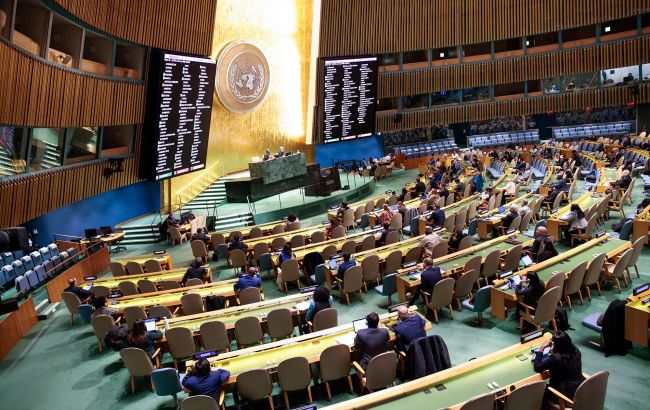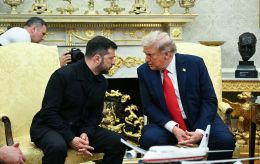UN General Assembly adopts resolution on Ukraine. US and Russia vote against it
 Photo: UN General Assembly (Getty Images)
Photo: UN General Assembly (Getty Images)
The UN General Assembly on Monday, February 24, adopted a resolution proposed by Ukraine and its partners with 93 votes in favor. Russia and the US voted against it.
RBC-Ukraine explains the significance of this resolution, the behind-the-scenes struggle surrounding it, and how it relates to the recent warming of relations between the US and Russia, particularly regarding Ukraine.
The UN General Assembly adopted a resolution demanding that Russia immediately withdraw its troops from Ukraine, with 93 votes in favor. 18 countries voted against it, while 65 abstained.
Among those who voted against were the US, Russia, Hungary, and Israel. Meanwhile, China abstained.

The resolution titled Promoting a Comprehensive, Just, and Lasting Peace in Ukraine was submitted by Ukraine in cooperation with more than 50 countries, including the majority of European nations.
Additionally, the UN General Assembly supported a US-submitted draft resolution on Ukraine with 89 votes in favor. The initial text did not specify Russia as the aggressor or call on it to withdraw its troops from the occupied territories.

However, the General Assembly amended the text of the US resolution, replacing the phrase "conflict between the Russian Federation and Ukraine" with "the full-scale invasion of the Russian Federation into Ukraine."
Following these changes, the amended US resolution garnered enough votes for approval. Russia voted against it, while the US abstained.
What the Ukrainian resolution entails
The Ukrainian document is largely in line with another resolution on Ukraine that the General Assembly adopted two years ago, on February 23, 2023, ahead of the first anniversary of Russia’s full-scale invasion. At that time, 141 UN member states voted in favor, while only seven (Russia and its satellite states) opposed it.
This resolution explicitly defines Russia’s actions as aggression, reaffirms Ukraine’s sovereignty within its internationally recognized borders, and calls for a lasting peace to be established this year strictly based on the principle of territorial integrity. It also demands that Russia fully and unconditionally withdraw all its armed forces from Ukraine’s territory, cease hostilities against Ukraine, and end all attacks on civilians and infrastructure.
Initially, it was expected that this resolution, especially given the strong backing from Western countries, would be adopted without major complications. However, the United States unexpectedly introduced its own alternative resolution.
US resolution on Ukraine
Unlike the relatively extensive Ukrainian-authored document, the US draft resolution was just nine lines long and simply "calls for the establishment of a lasting peace between Ukraine and the Russian Federation" without specifying any conditions or parameters for this peace or even identifying who the aggressor and the victim are.
This document sparked sharp criticism in Western media, including outlets generally supportive of Donald Trump's administration. For example, during a Fox News broadcast, US Defense Secretary Pete Hegseth, when asked why the US refused to acknowledge in the resolution the obvious fact that Russia had attacked Ukraine, responded that "assigning blame" does not bring anyone closer to peace.
Sources from multiple US media, as well as RBC-Ukraine's interlocutors, confirm that the US strongly urged Ukraine to withdraw its resolution so that only the American document would be submitted to the General Assembly. However, with the backing of many European countries, Ukraine refused.
Significance of the US resolution
The deliberately neutral US draft resolution is a clear indication of the shift in Washington's approach to the Russia-Ukraine war under Trump. Such "competition of resolutions" between Ukraine and its Western allies would have been nearly unthinkable before, as would the US reluctance to acknowledge the fact of Russian aggression against Ukraine.
After Ukraine refused to withdraw its resolution, the US engaged in behind-the-scenes maneuvering. Specifically, it sought to bring its resolution to a vote in the UN Security Council early in the morning New York time, even before the General Assembly session. However, China, which currently holds the Security Council presidency, rejected this request.
As a result, the Security Council will still review the US document, but only after the General Assembly. Formally, Security Council decisions hold higher authority as they are binding, whereas General Assembly resolutions are only advisory.
According to RBC-Ukraine's sources, the US resolution is almost certain to pass in the Security Council, requiring only nine out of fifteen votes in favor. More importantly, none of the five permanent members — US, Russia, China, France, and the UK — is expected to veto it.
If adopted, this would mark the first UN Security Council decision on Ukraine in three years of full-scale war — all previous ones had been blocked by Russia. However, the shift in the US stance under Trump appears to fully satisfy the aggressor state. The joint US-Russia vote on a Ukraine-related issue could be a test of whether further agreements between the two countries are possible — a path potentially opened by last week’s meeting between their representatives in Saudi Arabia.

